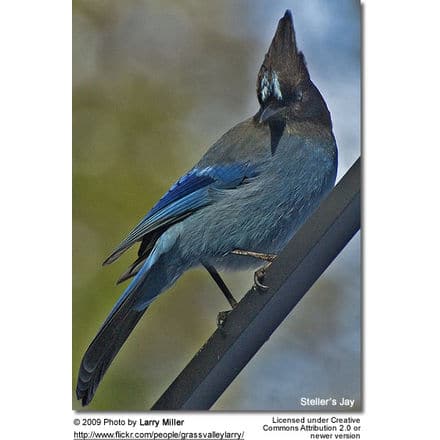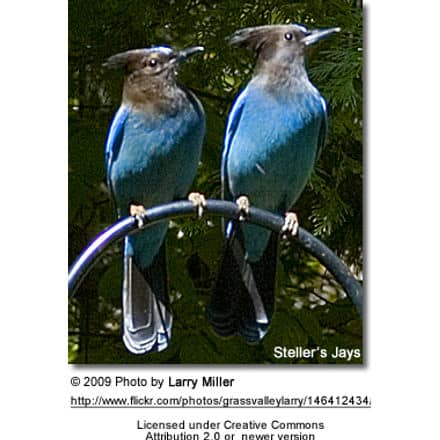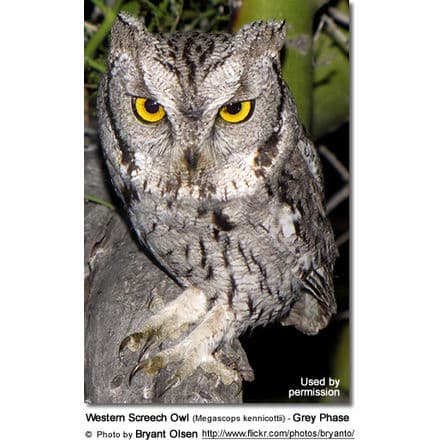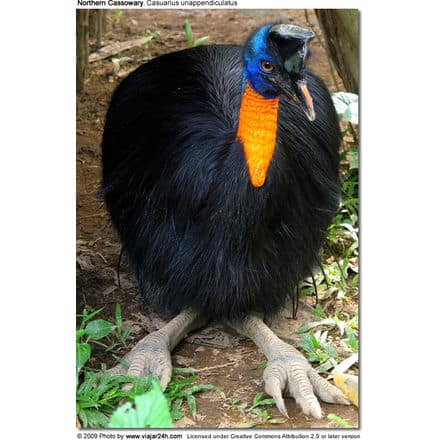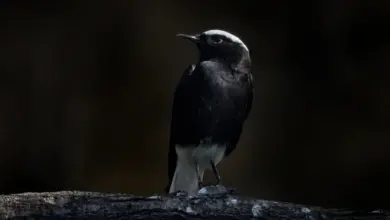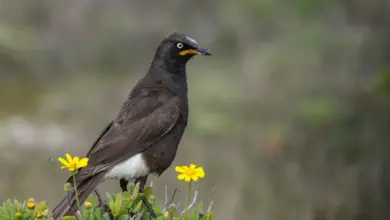Steller’s Jays (Cyanocitta stelleri)
The Steller’s Jays (Cyanocitta stelleri) are large songbirds that are native to western North America. Their range stretches from Alaska south through the United States into Mexico. Several subspecies are found in Central America.
They resemble their close relatives, the relatively common Blue Jays, found in the rest of the continent. However, the Steller’s Jays can easily be separated from their cousins by the black head and upper body.
The Steller’s Jay is the only crested jay west of the Rocky Mountains, and the Steller’s and the Blue Jays are the only uncrested jays found in North America. Depending on the subspecies, the crest can be either blue or black colored.
The Stellers and the Blue Jays are known to interbreed in areas where their ranges overlap.
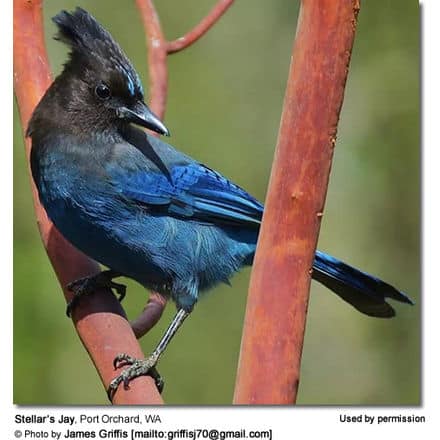
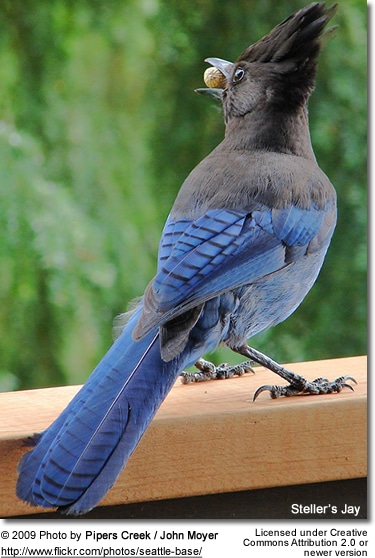
Multiple subspecies have been identified (not all are universally recognized) with a great deal of variation in appearance. These jays are locally known under a variety of names, including:
Long-crested Jays, Mountain Jays, Black-crested Jays, Coast Jays, Connective Jays, Osgood’s Jays, Queen Charlotte Jays, Sierra Nevada Jays, Blue-fronted Jays and Pine Jays.
These jays are excellent mimics and are able to imitate the sounds and calls made by other birds, cats, dogs, squirrels and environmental noises from their environment.
These jays are known to be quite aggressive with smaller birds, such as Juncos and Nuthatches, and have been observed attacking and even killing them. They will also steal and feed on the eggs and chicks of other birds.
The Steller’s Jay was originally named after the naturalist who discovered this species in 1741, Georg Steller.
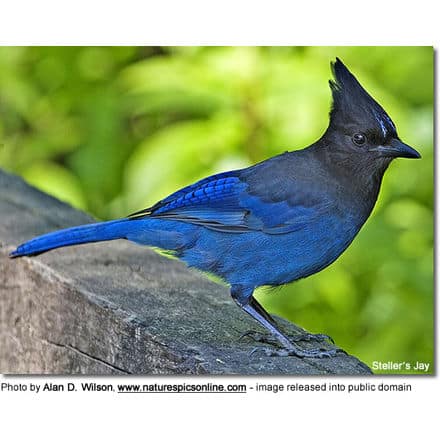
Distribution / Habitat
Steller’s Jays have a natural range that extends from southern coastal Alaska south through the Rocky Mountain region of Canada and USA south into Mexico ending in north-central Nicaragua in Central America.
These social birds are usually seen in flocks or pairs.
It is the provincial bird of British Columbia.
Subspecies and Ranges:
Geographic range:
- Steller’s Jay (Cyanocitta stelleri stelleri – Gmelin, JF, 1788) – Nominate Form
- Range: Southern Alaska and coastal British Columbia south to northwestern Oregon in the USA
- Queen Charlotte Jay or Queen Charlotte Steller’s Jay(Cyanocitta stelleri carlottae – Osgood, 1901)
- Range: Queen Charlotte Islands aka Haida Gwaii located on the North Coast of British Columbia in Canada
- Blue-fronted Jay or Blue-fronted Steller’s Jay (Cyanocitta stelleri frontalis – Ridgway, 1873)
- Range: Central Oregon to southern California to extreme northern Baja in Mexico
- Coast Jay(Cyanocitta stelleri carbonacea – Grinnell, 1900)
- Range: Marin and Contra Costa to Monterey counties of coastal California
- Central American Steller’s Jay (Cyanocitta stelleri [coronata])
- Highlands of central Mexico, from San Luis Potosí to northern Puebla
- Steller’s Jay (teotepecensis) (Cyanocitta stelleri coronata teotepecensis)
- Found in the mountains of southern Mexico, in central and southern Guerrero
- Steller’s Jay (ridgwayi) (Cyanocitta stelleri coronata ridgwayi)
- Occurs naturally in the highlands of Chiapas in southern Mexico south to Guatemala and El Salvador in Central America
- Steller’s Jay (restricta) (Cyanocitta stelleri restricta – Phillips, AR, 1966)
- Found in the highlands of Oaxaca in southern Mexico
- Steller’s Jay (purpurea) (Cyanocitta stelleri purpurea – Aldrich, 1944)
- Found in the highlands of western and central Michoacán in southwestern Mexico
- Steller’s Jay (azteca) (Cyanocitta stelleri azteca – Ridgway, 1899)
- Found in the mountains of central Mexico (México, Morelos, Puebla and west-central Veracruz)
- Steller’s Jay (lazula) (Cyanocitta stelleri lazula – van Rossem, 1928)
- Found in the highlands of El Salvador
- Steller’s Jay (suavis) (Cyanocitta stelleri suavis – Miller and Griscom, 1925)
- Found in the highlands of western Honduras to central Nicaragua in Central America
- Long-crested Steller’s Jay (Cyanocitta stelleri macrolopha)
- Found in the Rocky Mountains, from Nevada and Utah south to northern Sonora
- ID: Some have white streaks along the forehead and supercilium (“eye brow”).
- Black-headed Steller’s Jay (Cyanocitta stelleri annectens – Baird, SF, 1874)
- Found in Canada and USA, specifically in the interior British Columbia south to northeastern Oregon and northwestern Wyoming
- Long-crested Jay, Steller’s Jay (Cyanocitta stelleri diademata – Bonaparte, 1850)
- Found in the Sierra Madre Occidental mountain range, from southeastern Sonora to Chihuahua and Jalisco
- Steller’s Jay (Cyanocitta stelleri phillipsi – Browning, 1993)
- Found in Central Mexico in San Luis Potosí, Guanajuato and Hidalgo
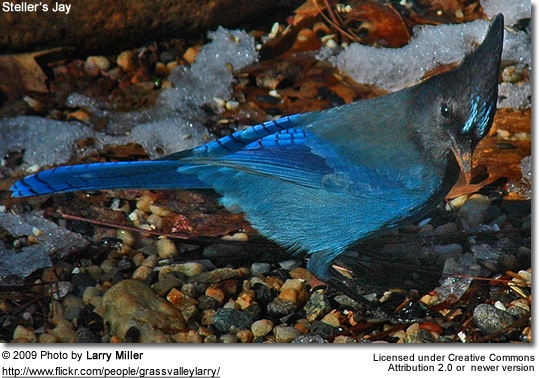
Description
Size
Length: 11.8–13.4 inches (30–34 cm)
Weight: 3.5 – 4.9 oz (100 – 140 g)
Plumage Details / Adults
Generally a dark-plumage jay with a charcoal black head and a blue body, somewhat lighter on the wings. Black barring on the wings.
Other Physical Details
- large head with a prominent triangular crest
- long, straight bill with a slight hook
- chunky bodies
- long tail
- rounded wings
Gender ID
Males and females look alike, except for some fainter and narrower bars in the barring pattern of females
Juvenile Description
- sooty grey plumage
- shorter crest
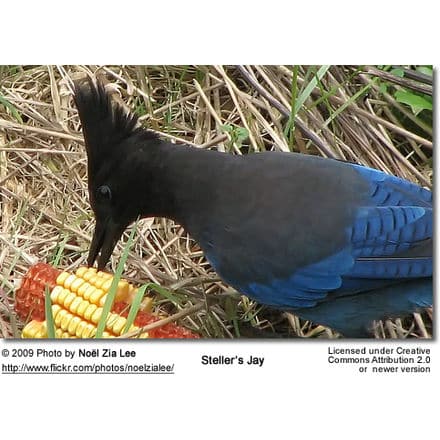
Diet / Feeding
The primary diet consists of nuts, a variety of seeds (such as pine seeds), acorns, nuts, berries, and other fruits. They are also known to feed on the eggs and chicks of other birds; and will hunt small invertebrates in their environment.
They also visit bird feeders and picnic areas in parks and campsites.
Breeding / Nesting
Nests are typically located in conifers or may be found in the cavities of trees, and are often found on horizontal branches close to the trunk and often near the top of the tree.
The cup nest is constructed by both parents out of stems, leaves, moss, and sticks, and held together with mud. It is lined with soft rootlets, pine needs, animal hair, and down.
A clutch consists of 2 – 6 greenish-blue, brown, or olive-speckled eggs that are incubated by the female for 16 – 18 days. Both parents raise the young, who take their first flight when they are about three weeks old.
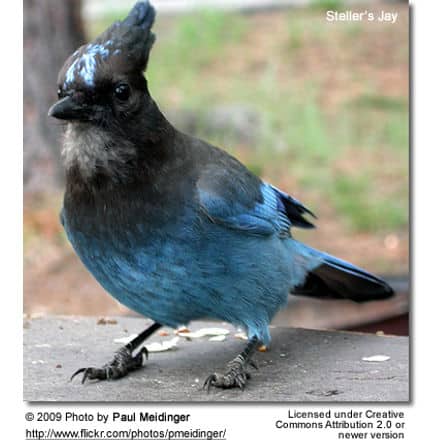
Calls / Vocalizations / Sounds
Calls include harsh nasal “wah“, “shack” or “shooka” sounds.
Alternate (Global) Names
Chinese: ???? … Czech: Sojka Stellerova … Danish: Fyrreskade … Dutch: Stellers Gaai … Estonian: tutt-sininäär … Finnish: Samettinärhi … French: Geai de Steller … German: Diademhäher, Schwarzkopfhäher … Hungarian: bóbitás szajkó … Italian: Ghiandaia di Steller … Japanese: suteraakakesu, sutera-kakesu … Norwegian: Furuskrike … Polish: modrosójka czarnoglowa, modrosójka czarnog?owa … Portuguese: Gaio-de-steller … Russian: ?????????? ??????? ?????, ?????????? ???????????? ??????? ?????, ???????????? ??????? ?????… Slovak: kapuciarka diadémová, Sojka diadémová … Spanish: Chara copetona, Chara Crestada, Chara de Steller, Urraca cejiblanca, Urraca de los … Swedish: Stellerskrika
Oldest Jay?
The oldest recorded Steller’s Jay lived 16 years and 1 month.

